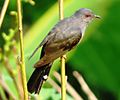Grey-bellied cuckoo
| Grey-bellied cuckoo | |
|---|---|

| |
| In Secunderabad, India. | |
| Scientific classification | |
| Domain: | Eukaryota |
| Kingdom: | Animalia |
| Phylum: | Chordata |
| Class: | Aves |
| Order: | Cuculiformes |
| Family: | Cuculidae |
| Genus: | Cacomantis |
| Species: | C. passerinus
|
| Binomial name | |
| Cacomantis passerinus (Vahl, 1797)
| |
The grey-bellied cuckoo or the Indian plaintive cuckoo (Cacomantis passerinus) is a cuckoo with widespread occurrence throughout Asia.
Description

The grey-bellied cuckoo is one of the smaller cuckoos, at a total length of about 23 cm. Adults are mainly grey with a white lower belly and undertail. There is a white patch on the wings. Some females are dark-barred reddish brown above with an unbarred tail and have strongly dark-barred whitish underparts. The juvenile resembles the female but is of a duller grey.[2]
Distribution and habitat
The grey-bellied cuckoo breeds in tropical southern Asia from India and Sri Lanka to south China and Indonesia. It has been reported from Bangladesh, Bhutan, India, the Maldives, Myanmar, Nepal, Pakistan, and Sri Lanka.[1] It is a short-distance migrant, since birds at more northerly latitudes and on higher ground are summer visitors, leaving for warmer areas in winter. The species prefers light woodland and cultivated areas.[2]
Ecology
The grey-bellied cuckoo is a brood parasite and uses warblers as hosts. It lays a single egg. Its diet consists of a variety of insects and caterpillars. this is a noisy species, with a persistent and loud pee-pip-pee-pee call, with its tail depressed.[2]
References
Gallery
-
in Secunderabad, India
-
with caterpillar in beak, in Andhra Pradesh, India.







